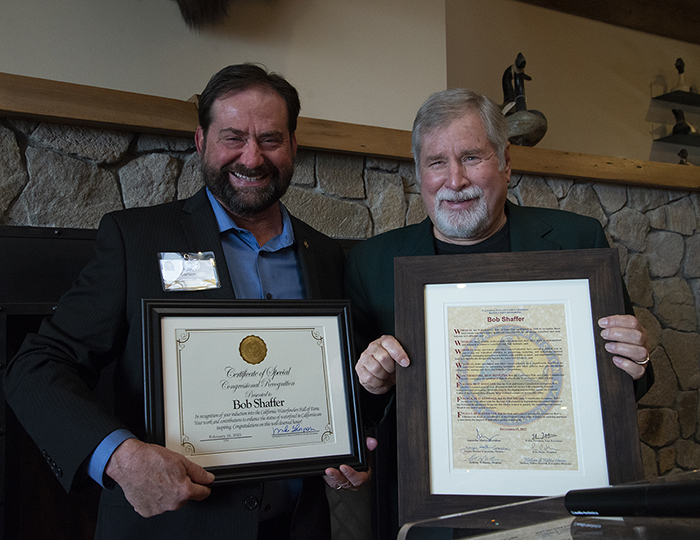
Feb 16, 2023
2022 Waterfowler's Hall of Fame
(Originally published in the Spring 2023 issue of California Waterfowl)
The waterfowl populations and waterfowl hunting we have in California have been built by great men and women who work in biology, conservation, lawmaking and art. The California Fish and Game Commission recognizes a few of these leaders each year in the California Waterfowler’s Hall of Fame. These are the people the commission honored in 2022.
WILLIAM F. BERRY
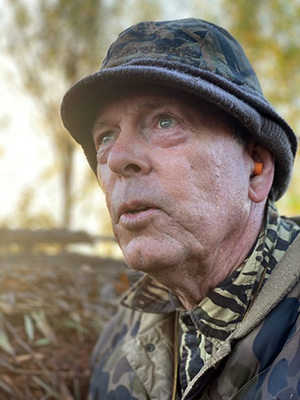
Philanthropist William F. Berry’s passion for waterfowl, wetlands and hunting started from when he was a child. He came from a long line of shooters who hunted both for sport and for survival. From the 1860s, the family hunted the now-dry Tulare Lake in the Central Valley and were known for being crack shots.
Berry belongs to many conservation groups including the California Waterfowl Association, Delta Waterfowl and Ducks Unlimited. His generosity through his philanthropic support to numerous wildlife organizations greatly aided these groups in their missions to protect natural resources. In addition to backing California Waterfowl’s lobbying efforts, over the years Berry voiced his support for wood duck habitat restoration, and conservation education and training for youth as well as California politicians.
With his son Derek, Berry started the C.J. Berry Foundation, a California public benefit corporation that awards grants to charitable organizations and emphasizes education and support for waterfowl conservation, art, culture, health and human services to benefit local communities and the environment.
Berry started hunting the Butte Sink’s Wild Goose Club in 1949 and continued to do so all the way until his retirement 70 years later. He said his one regret is the introduction of the spinning wing decoys in the fields and ponds because he thinks it’s such an attractant that it’s made duck hunting less of a fair chase. Outside of the waterfowl and wildlife world, Berry was involved in investment banking and had mining interests in Alaska, the Yukon and California.
BOB SHAFFER
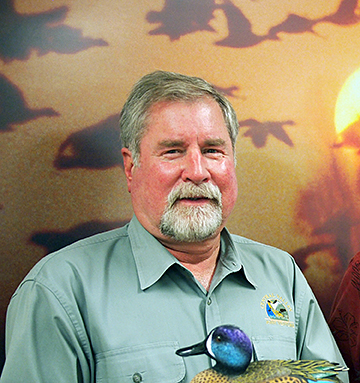
Bob Shaffer dedicated over four decades to federal service, focusing keenly on wetland restoration and protection. As a 15-year focus as the Central Valley Joint Venture (CVJV) coordinator, Shaffer was instrumental in unifying partners to maximize the impacts of individuals’ strengths.
Shaffer constantly strived to elevate the CVJV to become the top scientific and conservation Joint Venture on the continent, and his leadership in building unique partnerships across the CVJV forged many large wetland complexes and secured wetland restoration in the historically important Central Valley. As the Bureau of Reclamation’s CVJV representative, Shaffer found critical pilot funding for a variety of Joint Venture efforts. Most notably, he helped quantify limiting energetic parameters from which the Joint Venture goals were built by measuring the importance of winter flooded rice and seasonal wetlands.
In 2013, the North American Waterfowl Management Plan committee presented him with the National Blue-Winged Teal Award and recognized him for his achievements that benefited waterfowl and other wetland associated migratory bird populations and helped restore hundreds and thousands of acres of the Pacific Flyway’s migratory bird habitat.
Shaffer’s 26-year career with the Bureau of Reclamation was highlighted by his establishment of the Wetland Development Program, which offered financial assistance to build educational wetlands, helped sponsor the first and successive California Duck Days events, and provided grants for the Yolo Basin Foundation’s Discover the Flyway outdoor education program for K- to 12th-graders.
GLENN OLSON
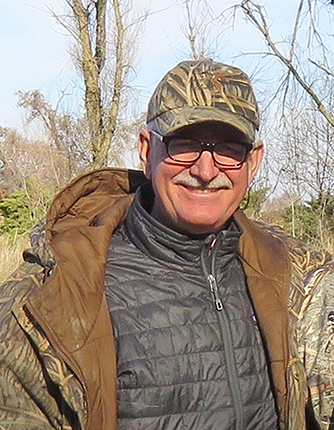
Over the course of his nearly 40-year career with Audubon, and now as an independent consultant, Glenn Olson dedicated his energy and expertise to protecting and enhancing bird species, biodiversity and habitat. He partnered with various organizations, individuals and agencies to bring people together to create durable and lasting outcomes for waterfowl populations and Pacific Flyway habitat.
Olson, who earned a bachelor’s degree in zoology and a Master of Public Health, secured agreements and funding for improving numerous wetland restoration and protection projects in areas including the Stone Lakes, San Joaquin River, Upper Klamath Marsh and Stillwater national wildlife refuges, and on Oahu. With Audubon, his efforts helped lead to purchases of water, islands and agricultural ground, and eventually led to the creation of the Paul L. Wattis Waterfowl Sanctuary.
Olson readily took on a multitude of roles over the years, including as Audubon’s senior vice president and director of field programs, executive director, and Donal O’Brien chair in Bird Conservation and Public Policy of the National Audubon Society. He helped found the Central Valley Waterfowl (now All Bird) Joint Venture and create the California Wetlands and Waterfowl Stewardship council to raise money and move wetland projects forward.
And besides building Pacific Flyway relationships with Alaskan tribes, coordinating Earth Day celebrations for youth, and advocating for education and conservation, Olson served on the Neotropical Migratory Bird Conservation Act Advisory Group, plus the North American Wetlands Conservation Act Council from 2010 until now.
JIMMY SMITH
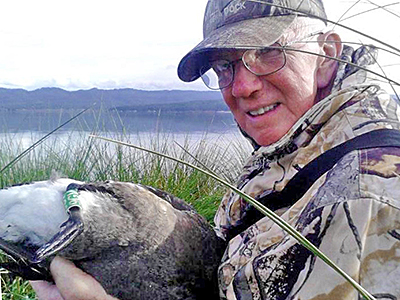
Jimmy Smith was a commercial fisherman for 40 years and a wildlife biologist. He helped state and federal wildlife agencies with migratory and resident waterfowl studies, and he utilized his extensive knowledge of birds and local landowners to lead banding crews on the north coast.
Smith served on numerous committees and working groups to improve California’s fish and wildlife habitats, including on the Humboldt County Board of Supervisors for over a decade, where he was also chair of the board for two years.
In the 1970s, Smith led an effort to change the North Humboldt Bay oyster culture from bottom-growth to longline above-bottom methods. Decades later, the transition away from bottom-growth aquaculture — which requires suction dredging and negatively impacts eelgrass — allowed the eelgrass to recover, providing critical food for black brant in the North Bay.
He also led the teams that achieved the clean-up, public acquisition, re-opening, enhanced protection and ongoing effective management of the Mike Thompson Wildlife Area, which maintained the area as important habitat for brant and kept hunting areas accessible.
Smith facilitated the acquisition of multiple wildlife areas in Humboldt County and coordinated meetings between the state and landowners/ranchers to promote better land management practices. He was crucial in the North Coast Waterfowler’s effort to introduce breeding Canada geese to the north coast in the early 1990s. The Jimmy Smith Fields Landing Boat Launching Facility was named in his honor due to his role in building partnerships and securing funding at the facility, which serves as the primary boating access to the southern part of Humboldt Bay.
JIM SEDINGER
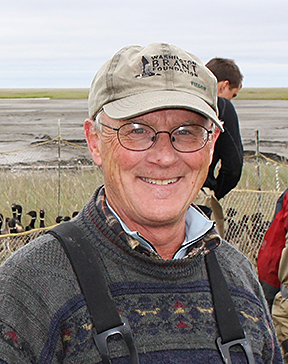
Waterfowl biologist Jim Sedinger received his PhD studying cackling geese from the University of California Davis in 1983. He was a student of and spent considerable time in the field with Dr. Dennis Raveling, mentored 30 graduate students, and has appeared as an author on nearly 200 scientific publications.
After earning his PhD, Sedinger moved to Alaska and worked for the U.S. Fish and Wildlife Service, later assumed a faculty position at the University of Alaska, Fairbanks, and initiated the long-term Tutakoke River Black Brant
research project. He then moved to work at the University of Nevada, Reno while continuing his Alaska brant project, which has provided publications vital to understanding the dynamics of the black brant population and updating brant harvest management in the mid-1990s. Aside from the scientific knowledge gained from his work, the presence of large numbers of marked brant piqued hunters’ interest and generated opportunities for discussion with hunters about variables affecting the species.
Sedinger served on CWA’s Traditions and Regulations Committee and was actively involved in discussing and assessing Adaptive Harvest Management in meetings organized by CWA. He provided insight on the importance of accounting for population size in harvest models and pointed out that harvest rates were being severely overestimated in models used to set pintail regulations. His findings influenced his own students to investigate harvest management and helped scientists improve harvest models.
Although he retired from teaching at the University of Nevada, Reno’s natural resources and environmental science department in 2019, Sedinger remains active in brant management and conservation.


